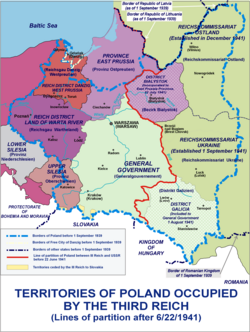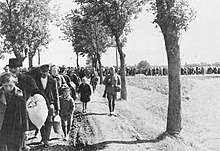Reichsgau Wartheland
| Reichsgau Wartheland Warthegau | |||||||||
|---|---|---|---|---|---|---|---|---|---|
| Reichsgau of Nazi Germany | |||||||||
| 1939–1945 | |||||||||
Gaue and Reichsgaue) with Warthegau area (bright yellow, right).  Reichsgau Wartheland (burgundy) on the map of occupied Poland | |||||||||
| Capital | Posen | ||||||||
| Government | |||||||||
| Gauleiter | |||||||||
• 1939–1945 | Arthur Greiser | ||||||||
| History | |||||||||
| 8 October 1939 | |||||||||
| 1 August 1945 | |||||||||
| |||||||||
| Today part of | Poland | ||||||||
The Reichsgau Wartheland (initially Reichsgau Posen, also Warthegau) was a
During the Partitions of Poland from 1793, the bulk of the area had been annexed by the Kingdom of Prussia until 1807 as South Prussia. From 1815 to 1849, the territory was within the autonomous Grand Duchy of Posen, which was the Province of Posen until Poland was re-established in 1918–1919 following World War I. The area is currently the Greater Poland Voivodeship.
Invasion and occupation of Poland

After the German Wehrmacht invaded Poland in September 1939, the German Reich occupied the whole of the Greater Poland area - the erstwhile Polish Poznań Voivodeship - and split the territory between four Reichsgaue and the General Government area (further east). The Militärbezirk Posen was created in September 1939; in accordance with a decree of 8 October 1939, Germany annexed it on 26 October 1939 as the Reichsgau Posen.[1]
He would remain in this post until the end of the war in 1945. Reichsgau Posen was renamed "Reichsgau Wartheland" on 29 January 1940.In the new Reichsgau Posen the Wehrmacht established
The territory of the Reichsgau was inhabited predominantly by ethnic Poles, by Germans (a minority of 16.7% in 1921), and by Polish Jews. Most of the Jewish residents were eventually imprisoned at the Łódź Ghetto (officially established in December 1939) and exterminated at Chełmno extermination camp (German: Vernichtungslager Kulmhof, operational from December 1941 onwards).[3]
Characteristics

The Gauleiter and
By the end of 1940, some 325,000 Poles and Jews from the Wartheland and the

End of war
By 1945 nearly half a million Germanic
See also
- History of Poland (1939–1945)
- World War II atrocities in Poland
- Special Prosecution Book-Poland
- Intelligenzaktion
- Volksdeutscher Selbstschutz
Notes
- ^
Neuburger, Otto (1944) [1943]. "Gazettes of the Länder and Reichsgaue". Official Publications of Present-day Germany: Government, Corporate Organizations and National Socialist Party, with an Outline of the Governmental Structure of Germany. Washington: U.S. Government Printing Office. p. 82. Retrieved 5 April 2024.
Reincorporated into Germany on October 26, 1939 as Reichsgau Posen by decree of October 8, 1939 (RGBl,I, p 2041).
- ISBN 978-1-932970-21-0.
- RSHA.
- ISBN 978-0-14-190959-2.
- ^ "Poles: Victims of the Nazi Era". United States Holocaust Memorial Museum. Retrieved 24 May 2013.
- ISBN 0-679-77663-X.
- ^ "Special treatment" (Sonderbehandlung)". The Holocaust History Project. Archived from the original on 2013-05-28.
- Polish Government in Exile."
- ^ Agency for the East that oversaw the registration, administration and eventual sale of all property confiscated from Poles and Jews (virtually all Polish and Jewish property was confiscated)Heimat, Region, and Empire: Spatial Identities under National Socialism Claus-Christian W. Szejnmann, Maiken Umbach
- ISBN 0-679-77663-X.
- ^ Max Hastings, "The Most Evil Emperor," NYRB October 23, 2008, p. 48.
- ^ Ian Kershaw, Hitler, the Germans, and the Final Solution (Yale University Press, 2008), p. 75.
- ISBN 978-0-300-18376-4.
In a keynote address to the Reichstag to mark the end of the 'Polish campaign', on October 6, 1939, Hitler announced the Heim ins Reich (Back to the Reich) program. The prospect of being uprooted from their homes to face an uncertain future not even in Germany proper, but in the considerably less salubrious environment of western Poland, was greeted with a deep sense of betrayal.
- ISBN 0674784057.
Sources
- Shoa.de - List of Gaue and Gauleiter (in German)
- Die NS Gaue at the Deutsches Historisches Museumwebsite (in German)
- Die Gaue der NSDAP (in German)
Further reading
- Huener, Jonathan (S2CID 145194931. - DOI 10.1017/S0008938914000648, online publication on 15 May 2014


